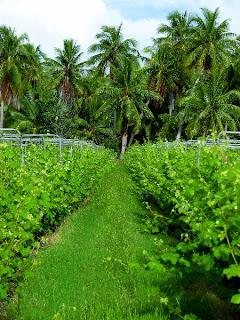
It's my first weekend back home after nearly a month in Southeast Asia so I decided to try and get back into the island groove with one of my favorite things in Tahiti:
maa tahiti, traditional Polynesian food baked in an earth oven. Now not all earth-cooked meals are equal; in fact they can go terribly wrong if the fire isn't hot enough, the food is uncovered too early, the food isn't fresh to begin with or if the food packages were prepared too lazily. One of my biggest pet peeves is when my favorite dish,
poulet fafa gets prepared with spinach instead of authentic taro leaves - it just doesn't taste the same.

Today I indulged in what I think is the best
maa tahiti on Tahiti, served at the Botanical Gardens Restaurant right next to said gardens and the Musee Guaguin. This place, in what should be the heart of tourist land but never gets any tourists, is one of my favorite places to eat in my area. The food is always fantastic and it's a simple down-home Tahitian style place with gravel floors, plastic chairs and Tahitian fabrics stapled on to the ceiling for decoration. The restaurant is right on the lagoon against a low breakwater, so you sometimes get splashed if the waves are too big; on weekends there's often a synth band playing cheesy Tahitian dance hall hits. Today the place was packed with a large party of old Tahitian women dressed up in their best and most colorful dresses, strings of black pearls and flower crowns. They were living it up, laughing and drinking cheap red wine bottle after bottle. Not a tourist was in sight despite the tour bus parked at the entrance to the gardens.

But back to the food. My daughter and I decided to split the
maa tahiti plate (about US$40; only available on Sundays), which is always huge, but when it arrived we all had to laugh because it could have comfortably fed three very hungry people. Every dish was perfect. I'm not a huge meat eater but the pork had a caramelized crispy layer on the fatty parts and tasted like candy. I had to restrain myself from eating too much of it. The
poisson cru (raw fish salad - click
here for my recipe) was fresh with a perfect lemon and coconut milk balance; the
poulet fafa had plenty of fafa (taro leaves), which is time consuming to prepare so often places skimp on it; there was perfectly cooked taro, bananas and sweet potatoes;
pua choux, a pork and cabbage stew; and last a whole separate plate of delicious
poe banane, a baked banana pudding topped with coconut milk. Many restaurants make
maa tahiti in conventional ovens but at the Botanical Gardens Restaurant you can faintly taste the wood smoke from their
ahimaa (pit oven), which gives it a more complex flavor.
Now I feel home. We finished off the meal with a long walk in the gardens while the restaurant kept our copious leftovers in their fridge for us. I think I'm having pork for breakfast tomorrow morning.
PS Now I'm back home I'll be back to blogging more regularly again!



















































